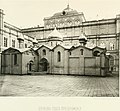Friedrich Richter (architect)
Friedrich Friedrichowitsch (Fjodor Fjodorowitsch) Richter ( Russian Фёдор Фёдорович Рихтер ; * 23 February July / 6 March 1808 greg. In Goldingen ; † 7 March July / 19 March 1868 greg. In Moscow ) was a German Baltic - Russian Architect , restorer and university professor .
Life
Richter, the son of an artist , entered the civil service in St. Petersburg in September 1827 and immediately became a draftsman for the construction of St. Isaac's Cathedral . At the same time he was a student at the Imperial Academy of Arts (IACh) . In 1833 he completed his studies as a first-class architecture artist with a gold medal and a scholarship for further studies. In May 1834 he traveled to Italy with the task of studying the architecture there and, on his return, presenting the graphic reconstruction of an architectural monument. In September 1839 the IACh appointed him an academic in architecture. In 1840 he became a member of the Accademia di Belle Arti di Brera . In 1841 he became a professor at the IACh. In February 1841 he was seconded to the Moscow Building Commission and sent to build the Great Kremlin Palace . In 1843 he became the chief court architect and designed the Vladimir Hall and the Alexander Hall of the Great Kremlin Palace. To this end, he directed the construction of the armory of the Moscow Kremlin . 1844–1847 Richter built the Annunciation Church for Anna Dmitrijewna Naryschkina next to her dacha in Moscow's Petrovsky Park. He led the reconstruction of the Khamovnichesky barracks (Komsomolski Prospect 18–22).
From 1842 Richter was director of the Moscow Court Architecture School, which in 1865 merged with the Moscow School of Painting, Sculpture and Architecture with Richter as a council member. In 1850, Richter's six-volume work on the monuments of Old Russian architecture with drawings and plans of the facades and floor plans was published, which is in the library of the Moscow Architecture Institute . A second edition appeared in 1856. In 1856 Richter was appointed to the Real Council of State (4th class ).
From the beginning of the 1850s Richter worked as a restorer. His assistant was Nikolai Ivanovich Finissov . He restored the Cathedral of the Annunciation in the Moscow Kremlin , the Bowovitskaya Tower of the Kremlin, the (not preserved) Spas-na-Boru Cathedral in the Moscow Kremlin, the walls of the Pskov Kremlin , the church in Dubrovitsy near Podolsk (1850) , a church in Chekhov Raion (1853-1859), the Romanov Palace in Moscow (1858-1859 with Alexei Protogenowitsch Popow ) and the Ipatios Monastery (1862).
Honors
- Diamond ring (1827, 1840)
- 5000 silver ruble ratification (1849)
- Russian Order of Saint Anne II Class (1849, Imperial Crown to the Order 1851)
- Order of Saint Vladimir IV Class (1856)
- Order of the Red Eagle
Works
Web links
Individual evidence
- ↑ a b c d А. П. Новицкий: Рихтер, Федор Федорович . In: Русский биографический словарь . tape 16 , 1913, pp. 247252 ( wikisource.org [accessed March 1, 2018]).
- ↑ А. В. Рогачев: Зодчие Москвы времени эклектики, модерна и неоклассицизма (1830-е – 1917 годы). Иллюстрированный биографический словарь . Фирма "КРАБиК", Moscow 1998, ISBN 5-900395-17-0 , p. 210-211 .
- ↑ Рихтер Ф .: Памятники древнего русского зодчества, снятые с натуры и представленные в планах, фасадах, разрезах, с замечательнейшими деталями украшений каменной высечки и живописи . 1850.
- ↑ Памятники древнего русского зодчества (accessed March 2, 2018).
- ↑ Список гражданским чинам первых IV классов . В типографии Собственной Е. И. В. Канцелярии, St. Petersburg 1856, p. 759 .
| personal data | |
|---|---|
| SURNAME | Richter, Friedrich |
| ALTERNATIVE NAMES | Richter, Friedrich Friedrichowitsch Fjodor Fjodorowitsch (full name); Рихтер, Фёдор Фёдорович (Russian) |
| BRIEF DESCRIPTION | Russian architect, restorer and university professor |
| DATE OF BIRTH | March 6, 1808 |
| PLACE OF BIRTH | Goldingen |
| DATE OF DEATH | March 19, 1868 |
| Place of death | Moscow |








